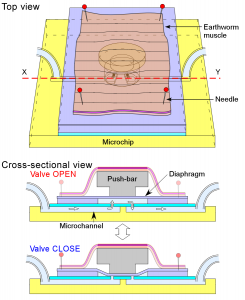News
Creation of earthworm muscle-based valve
A research group of Dr. Yo Tanaka (Group B01, RIKEN) has developed the first microchip valve powered by living cells. Earthworm muscle tissue allowed for a high contractile force that could be sustained for minutes, and unlike electrically controlled valves, did not require any external power source such as batteries.
For several decades, researchers have been trying to combine microelectromechanical systems (MEMS) with living material. Bio-MEMS have many applications, ranging from improved drug delivery and optical and electrochemical sensors to organs-on-chips. The team has been developing a bio-MEMS that is driven by real muscle, which could be useful in surgical implants. Building on their on-chip micropump design, the new study is the proof-of-concept for an on-chip muscle-driven valve.
In mechanics, an actuator is the part of a machine that controls a mechanism by making it move, such as the opening and closing of a valve. Actuators require a power source and a control signal, which are typically electric current or some kind of fluid pressure. The main advantage for using muscles as actuators in bio-MEM systems is that they can be powered the same way as they are in living bodies: chemically. For muscles, the signal for contraction is the molecule acetylcholine—which is delivered by neurons—and the energy source is adenosine triphosphate (ATP)—which exists inside muscle cells.
The team initially determined that a small 1 cm × 3 cm sheet of earthworm muscle could produce an average contractile force of about 1.5 milli-newtons over a 2-min period when stimulated by a very small amount of acetylcholine. Using this data, they build a microfluid channel and valve on a 2 cm × 2 cm microchip that could be controlled by the contraction/relaxation of earthworm muscle.
To test the system, they used a microscope to monitor fluorescently labeled microparticles in liquid as they flowed through the microchannel. When acetylcholine was applied, the muscle contacted. The resulting force was transduced to a bar that was pushed down to close the valve, which successfully stopped the flow of liquid. When the acetylcholine was washed away, the muscle relaxed, the valve re-opened, and the fluid flowed again.
The study was published in Scientific Reports on July 8.
Paper title: A valve powered by earthworm muscle with both electrical and 100% chemical control
Link to the paper: https://www.nature.com/articles/s41586-019-1479-6
